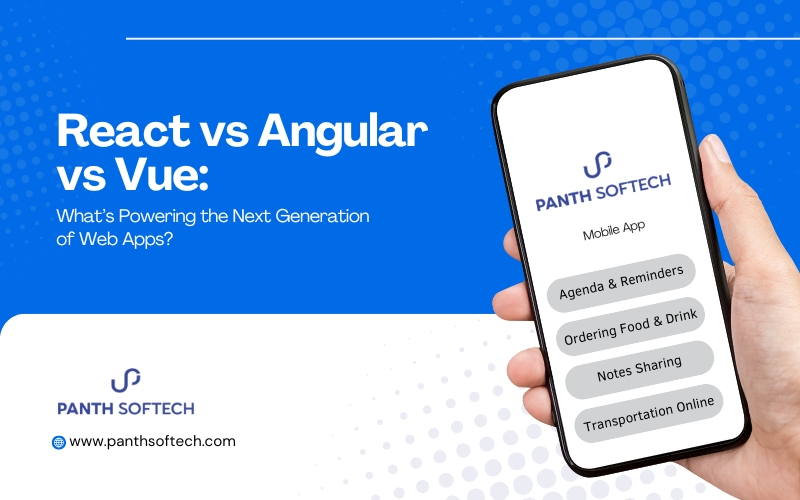Front-end technology has become the foundation of every modern digital product, and choosing the right framework can shape the entire future of your application. From performance and UI behavior to long-term scalability and maintenance, the framework you rely on plays a major role in how your product evolves. Startups need something lightweight and fast to build momentum, while enterprises require stable, secure, and scalable architectures. At Panth Softech, our expertise in web application development services puts us at the center of this decision-making process, and clients often ask us the same question:
“Which framework will give our web application the best long-term advantage—React, Angular, or Vue?”
Each of these front-end frameworks has shaped the industry in unique ways. They power millions of apps and play a massive role in enterprise-grade web solutions across the globe. But which one is powering the next generation of web apps? And which one should you choose?
This blog breaks down the differences between React, Angular, and Vue—from performance and scalability to learning curve and enterprise suitability—so you can make the right decision.
Why the Right Framework Matters
Before comparing, it’s important to understand why framework selection matters.
Your choice of technology affects:
- How fast your app loads
- How easy it is to scale
- How flexible your UI can be
- How secure your data is
- How easily your development team can maintain the code
- How future-ready your product stays
The demand for enterprise-grade web solutions has increased, and companies want cloud-ready web application frameworks that don’t just work today—but stay relevant for years.
Now, let’s look at the three giants shaping the modern JavaScript ecosystem.
React: Built for Performance and UI Flexibility
React, created by Facebook (Meta), is one of the most popular choices for modern web application development. It’s technically a library, not a full framework, but its flexibility is what makes it powerful.
Why Enterprises Love React
- Excellent for building dynamic, interactive user interfaces
- Virtual DOM ensures fast performance
- Huge ecosystem and community support
- Easy integration with back-end APIs for full-stack web development services
- Works seamlessly with cloud platforms and headless architectures
React is especially popular among companies wanting customizable web application frameworks and high UI flexibility.
Best Use Cases
- High-traffic apps
- Data-heavy dashboards
- Scalable enterprise portals
- SaaS platforms
- Cross-platform apps using React Native
Pros
- Lightweight and fast
- Flexible architecture
- More freedom for developers
- Large pool of ready-to-use components
Cons
- Not a complete framework—requires additional libraries
- More decisions required (routing, state management, etc.)
Angular: The Enterprise-Grade All-In-One Framework
Angular, developed by Google, is a complete end-to-end framework perfect for complex enterprise applications. It is opinionated, structured, and ideal for large teams working on long-term software.
Why Enterprises Choose Angular
- Offers everything built-in (routing, state management, form handling, testing)
- Focuses heavily on security and scalability
- Strong structure—perfect for enterprise teams
- Excellent for enterprise web application frameworks that need consistency
Angular is preferred by businesses that want proven front-end framework best practices integrated directly into their enterprise software solutions.
Best Use Cases
- Enterprise management systems
- Large internal dashboards
- Banking, healthcare, insurance platforms
- Cloud-ready, mission-critical apps
Pros
- Complete framework
- Strong TypeScript support
- Great maintainability
- Highly secure
Cons
- Steeper learning curve
- Heavier performance compared to React and Vue
Vue: The Lightweight and Developer-Friendly Framework
Vue is known for being simple, fast, and very easy to learn. It provides the structure of Angular with the flexibility of React—making it perfect for startups and mid-sized applications.
Why Developers and Startups Prefer Vue
- Very easy learning curve
- Lightweight and highly performant
- Flexible architecture
- Perfect for small to medium enterprise solutions
- Great community support
Vue is often chosen when companies want flexible UI frameworks for web products without unnecessary complexity.
Best Use Cases
- Startups building MVPs
- Progressive web apps
- Lightweight enterprise tools
- Consumer-facing interfaces
Pros
- Simple and intuitive
- Faster than many frameworks
- Low cost of development
- Great documentation
Cons
- Smaller corporate backing compared to React and Angular
- Fewer large-scale enterprise case studies
React vs Angular vs Vue: Comparison at a Glance
Below is a clear comparison of React, Angular, and Vue for enterprises and startups:
| Feature | React | Angular | Vue |
| Type | Library | Full MVC Framework | Progressive Framework |
| Learning Curve | Medium | High | Easy |
| Performance | Excellent | Good | Excellent |
| Best For | Interactive UIs, scalable apps | Enterprise apps, large systems | Lightweight, fast apps |
| Flexibility | High | Moderate | High |
| Language | JavaScript + JSX | TypeScript | JavaScript |
| Community Support | Very Strong | Strong | Growing |
This table helps when choosing front-end technology for startups and enterprises depending on project needs.
Which Framework Should You Choose?
When comparing React vs Angular vs Vue for enterprise apps, three points matter most: scalability, maintainability, and long-term stability.
For Large Enterprises — Choose Angular
Angular often leads because it offers:
- Built-in architecture
- Strong security
- TypeScript-first approach
- Predictability for large teams
- Standardized coding practices
For Mid-Sized Scalable Products — Choose React
React is usually the top choice:
- Flexible
- Cloud-ready
- Easy integration with microservices
- Large talent pool
- Great ecosystem for SaaS
- Easy to mix with any backend (Node, Python, .NET, etc.)
For Startups and Lightweight Enterprise Solutions — Choose Vue
Vue wins because:
- Easy to learn
- Extremely fast
- Perfect for MVPs and iterative development
- Lower budget and development time
- Ideal for small teams
Which Framework Is Powering the Next Generation of Web Apps?
The truth is—all three are powering the future, but in different ways:
- React leads in innovation for UI and cross-platform apps.
- Angular dominates enterprise ecosystems and mission-critical platforms.
- Vue excels in fast, flexible, user-friendly app development.
The “best” framework depends on your business needs, application complexity, team size, and future goals.
How Panth Softech Helps You Choose the Ideal Framework
At Panth Softech, we specialize in building scalable, secure, and modern digital products through our web application development service. Our team helps businesses:
- Choose the right technology
- Build cloud-ready architectures
- Develop enterprise-grade web solutions
- Implement customizable web application frameworks
- Offer full-stack web development services
- Ensure long-term stability and maintenance
Whether you need React, Angular, or Vue, we help you make a decision that aligns perfectly with your product vision.
Conclusion: Choose Technology That Matches Your Vision
React, Angular, and Vue are all powerful in their own areas. Instead of asking “Which is better?”, focus on the questions that truly matter:
- What does your business need today and in the future?
- What kind of experience do your users expect?
- How should your platform grow over the next 3–5 years?
For expert help building modern, scalable, and future-ready web applications, Panth Softech is your trusted partner.
Need Help Choosing the Right Framework?
Whether you’re planning a new web app or upgrading an existing one, our team is here to guide you. Contact us today to discuss your project and get a tailored solution.




